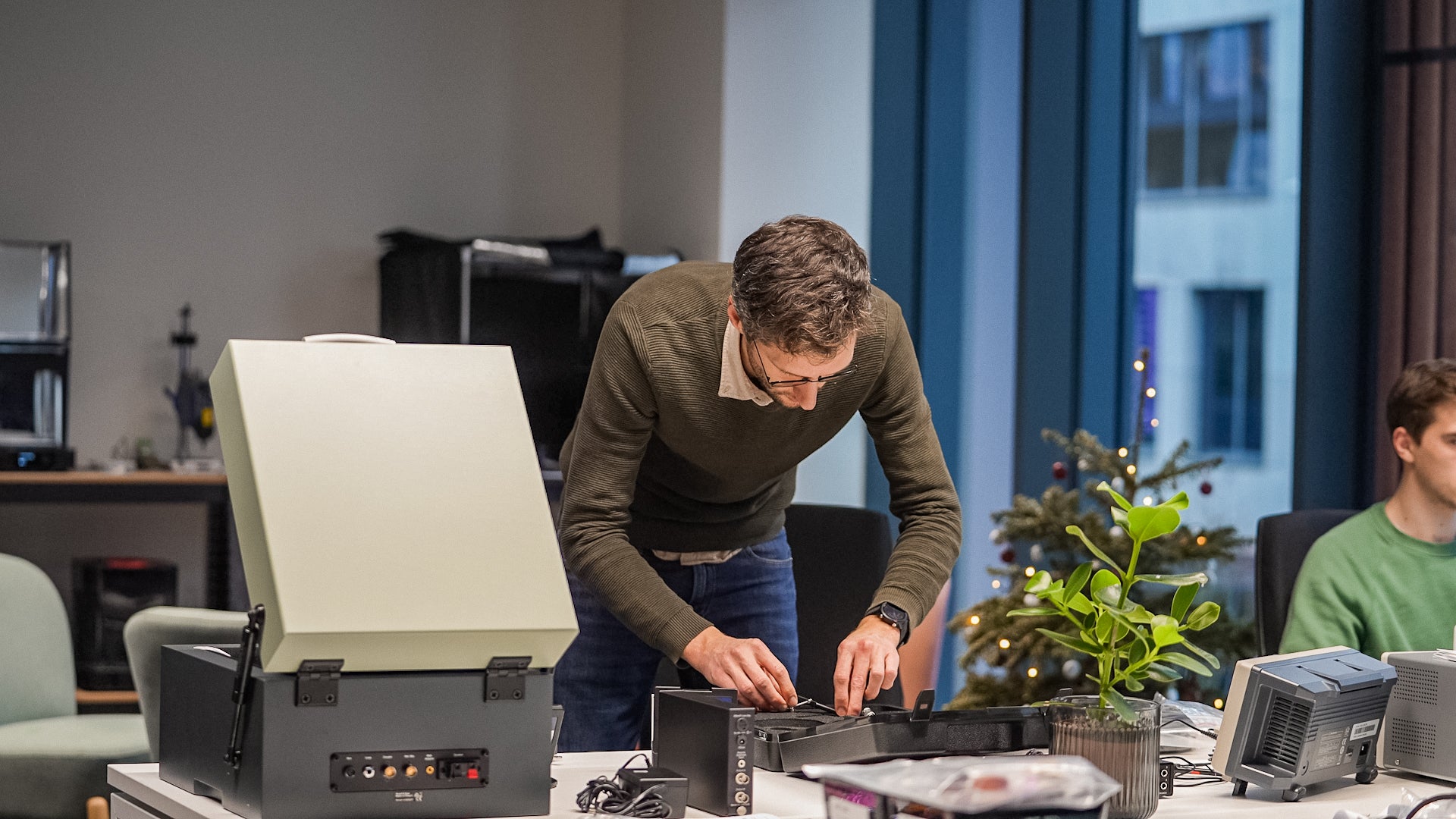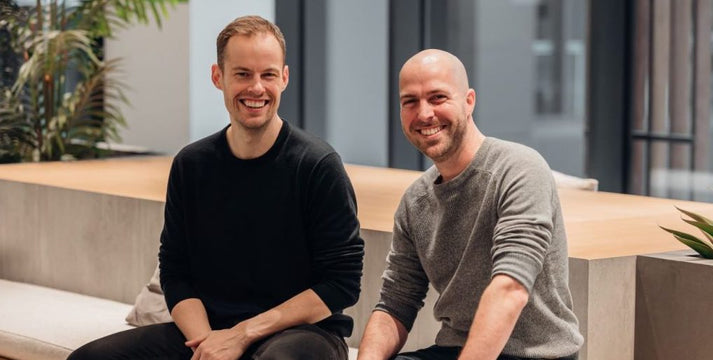At Loop we have, on average, about 20-30 product development programs running at once. Luckily, we have a well-defined (but ever-evolving) way to manage them. Our Engineering Program Manager, Robert, and Manager of Sustainability, Sander, break down how it gets done.
Stage Gate Methodology with an agile mindset
We use the Stage Gate Methodology. Moving through distinct phases – from opportunity identification to final delivery – allows us to maintain a high degree of precision and accountability.
Each stage demands specific deliverables from various teams, including industrial design, user insights, technology, engineering, quality, and sourcing. This structured approach allows for detailed planning and review, which ensures that every step is executed successfully before any subsequent step is begun.
While the methodology is our central framework, it’s continually refined to optimize our processes. The goal: to make every product launch a success in every aspect, from design to manufacturing to operational excellence. And, of course, the most important metric of them all: adding tangible value for our customers.

Going through the process step-by-step
We kick our programs off by identifying a clear market opportunity for a new or improved product. We look for a product-market gap and how to fill it. From there, we explore potential solutions, aligning them with identified user needs to ensure that we’re keeping our customers front and center. The conceptualization phase is key in our development cycle, it’s where we determine which ideas transition into actual products.
This phase is followed by rigorous development and validation stages, ensuring the product is not only manufacturable but also fits the cost boundaries, mass production requirements, and sustainability criteria. The final launch is also planned and timed precisely, to make sure we deliver earwear that truly adds value to the users.
The Stage Gate Methodology is a high-level standardized framework. By keeping it simple and clear, it enables the teams involved in the programs to work agile within the stages themselves.
A single source of truth and a framework of meetings to set the bar
We use Monday.com to maintain a structured workflow and to keep everybody informed and involved. It allows us to track deliverables, monitor potential risks, and ensure that every team member is aware of the project boundaries and requirements. This is our single source of truth for all project variables.
This approach helps us anticipate changes and manage risks proactively, which helps to pivot the programs if needed and to avoid feature creep.
We also have structured communication through a defined meeting rhythm which makes sure we don’t go astray. Thanks to these meetings, all team members, from core to extended teams and stakeholders, are regularly updated and aligned with the project progress:
- Project team meetings – The core team usually gets together every week. Sometimes, when we're in a crunch phase, these are even daily.
- Functional team meetings – All the program managers, engineering leads, and designers get together to review potential issues or challenges.
- Stakeholder updates – A weekly session to present the status of all the programs to all other stakeholders internally, from quality, operations, product marketing, etc. So, they always know within a week if there’s a significant change in any of the programs.
- Gate review meetings – Programs that are about to exit a phase from the stage gate methodology can ask for a slot and present to a select group of decision-makers including our founders, VPs, and directors. This is where they get the ‘GO’ to move to the next phase.
Each meeting type is designed to review ongoing issues, escalate critical decisions, and confirm that all deliverables meet our criteria before moving to the next phase. This standardized communication framework not only keeps our teams efficient but also agile enough to respond quickly to any issues or adjustments needed, ensuring ongoing progress and stakeholder engagement throughout the development cycle.
High risk, high rewards?
An important part of our work is mitigating risks in time, while keeping the fast pace we have here at Loop. We want to find and address significant risks before they impact the project timeline.
Obviously, our products are designed to be worn in-ear. This means we face unique challenges related to acoustic specifications and user comfort. A lot of (user) testing is essential to ensure that the products meet the specific user needs. This can have consequences for the timelines, due to the extensive nature of these evaluations.
Production is another major concern, as what works in a prototype may not be a fit for mass production. And then aesthetics also play a huge role. Our earwear needs to look stylish, without losing comfort and functionality.
From the start – once we identify the opportunities – risk management is integral to our development process. This also involves evaluating the capability of our existing supplier network and potentially seeking new suppliers who can meet production and quality demands at a reasonable cost. The balance of manufacturing feasibility, cost-effectiveness, and timely launch feeds our strategic decision-making.
Getting to the finish line together
Having the Stage Gate Methodology and standardized communication in place doesn’t mean there are no challenges. As a program manager deeply embedded in each project's intricacies, you must be constantly aware of all potential options and their consequences.
The critical aspect of this role involves leading decision-making processes during core team meetings or gate reviews, ensuring that all necessary perspectives and risks are clearly understood and addressed. This requires the ability to guide diverse teams and stakeholders toward a decision, often under pressure to balance speed, cost, and risk effectively.
Not an easy task in any product development process, but here at Loop, we also deal with massive growth in teams and ambitions. That growth comes with increased complexity, particularly in communication.
The challenge lies in ensuring all team members, stakeholders, and leadership are continually aligned on the project's progress and decisions. This is why keeping the system as simple and streamlined as possible is so important. By standardizing tools and communication methods, we minimize administrative tasks, allowing team members to focus on their specific roles.
Thankfully, growing quickly also comes with its advantages. The last few years we have built teams composed of some real talented, specialized people, which makes working on these projects together a joy.
Of course, there are challenges, risks, and high expectations, but working with all these people who are such experts in their specific topic makes you really come together as a team and get it done. Seeing the enthusiastic reviews of our customers after launch also helps, of course.
Does working in any phase of our product development programs sound like your next challenge? Look at our open positions in the product team!

The Founders Story
Earplugs, suck! There .... we said it 😜 At least, that's what our co-founders Dimitri O and Maarten Bodewes learned w...

The reality of a workaway
Traveling is a big part of who we are at Loop. But we also need to work. And then it hit us, why not combine the two?

Tips for giving tips: How we build a constructive feedback culture
When it comes to actually giving that feedback to others, we tend to get a bit nervous. We love giving kudos, high f...

















